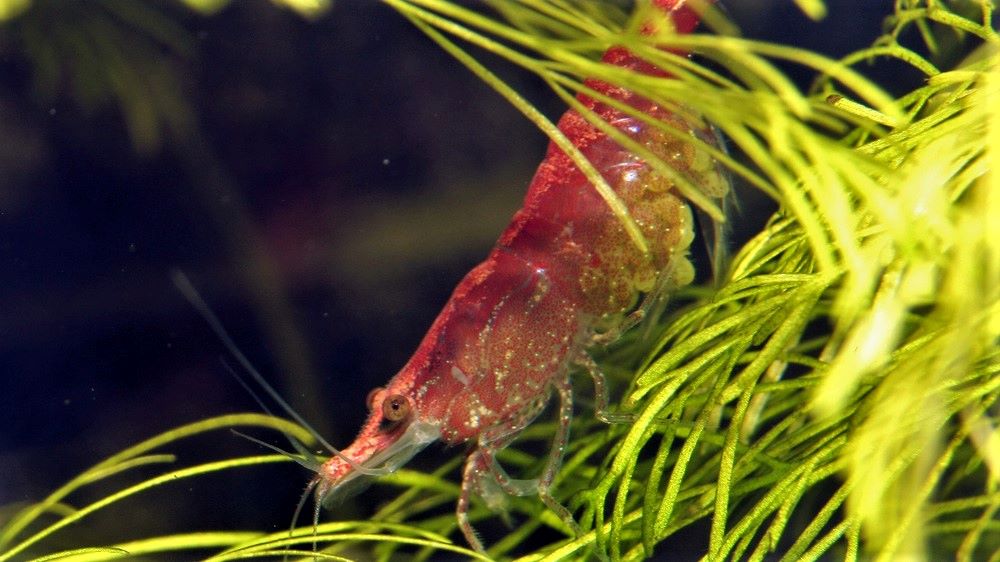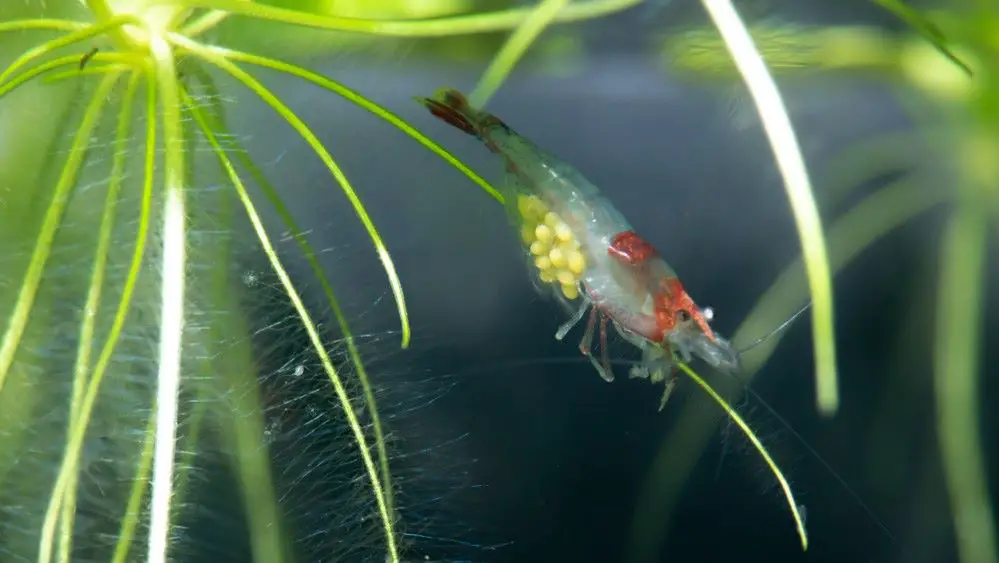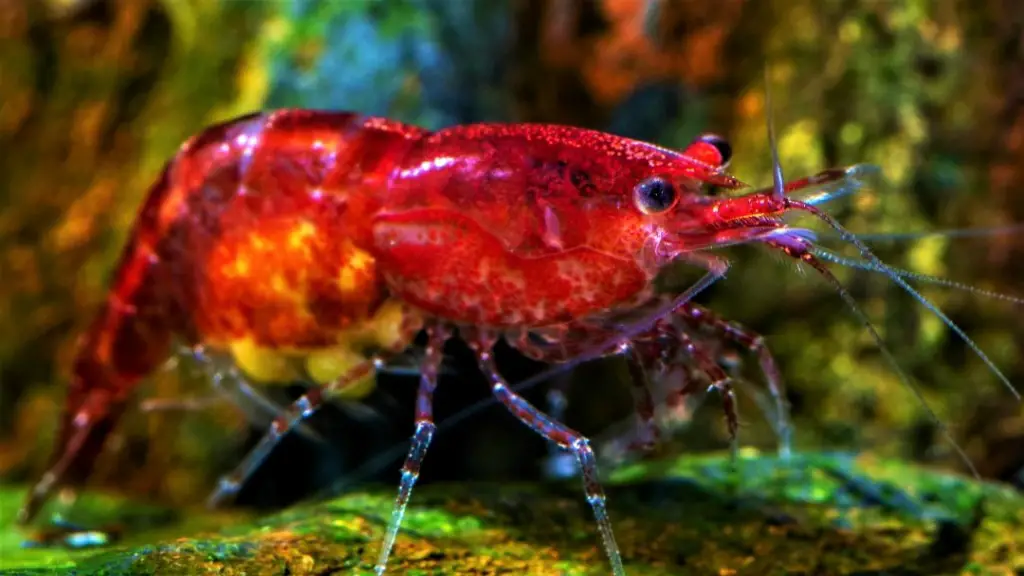Cherry shrimp, on average, carry around 20 to 30 eggs. However, the exact number can vary depending on several factors, such as the shrimp’s age, health, and the tank’s conditions.
As a seasoned shrimp keeper, I’ve spent hours observing the fascinating life cycle of the cherry shrimp. I remember the first time I noticed a female carrying eggs. It was a moment of pure excitement, a testament to the thriving conditions in my tank.
Over the decades, I’ve noticed that the number of eggs a cherry shrimp carries can vary quite a bit. In my experience, a healthy, mature female can carry around 20 to 30 eggs in optimal tank conditions. However, this number can fluctuate based on the shrimp’s health and the environment.
In this blog post, we’ll dive deeper into the factors influencing the number of eggs a cherry shrimp carries and explore some intriguing aspects of their reproductive cycle.
So, let’s embark on this egg-citing journey!

The Life Cycle of the Cherry Shrimp: An Overview
The life cycle of the cherry shrimp, or Neocaridina davidi, is a captivating process that unfolds over several stages. It all begins when a female cherry shrimp carries a clutch of eggs under her abdomen. This period, known as being “berried,” is a sight to behold, with the female shrimp toting around her precious cargo with utmost care.
The eggs, which are typically in the range of 20 to 30 for a healthy, mature female, are fertilized by the male before they are carried by the female. The fertilization process happens during a brief window after the female molts and before the new exoskeleton hardens. The male shrimp, sensing the female’s readiness to mate through pheromones, will fertilize the eggs, which the female then carries in her swimmerets, the small leg-like appendages under her abdomen.
The female cherry shrimp carries these eggs for about 30 days, constantly fanning them with her swimmerets to provide oxygen and prevent fungal growth. During this time, the eggs transition from a bright green color to a darker hue, indicating the development of the shrimplets inside.
Once the eggs hatch, the tiny shrimplets are fully formed, albeit in a miniature size. They are independent from the moment of birth, beginning their lives by foraging for food and growing rapidly. Within a few weeks, the shrimplets will resemble miniature versions of their parents, and by two to three months, they will be sexually mature and ready to start the cycle anew.
The life cycle of the cherry shrimp is a testament to the resilience and adaptability of these tiny creatures. From carrying a clutch of eggs to nurturing independent shrimplets, the journey of a cherry shrimp is filled with fascinating stages that reflect the intricate beauty of aquatic life.

Factors Influencing the Number of Eggs in Cherry Shrimp
When it comes to the number of eggs a cherry shrimp carries, several factors come into play. While the average number hovers around 20 to 30 eggs, this can vary based on the shrimp’s age, health, and the conditions of the tank.
Age: Age is a significant factor in determining the number of eggs a cherry shrimp can carry. Younger shrimp, in their first few reproductive cycles, may carry fewer eggs than their older, more mature counterparts. As the shrimp ages and grows larger, it can accommodate more eggs, leading to larger clutches.
Health: The health of the shrimp is another crucial factor. A healthy, well-fed shrimp in optimal conditions is likely to carry more eggs than a shrimp that is stressed or malnourished. Proper nutrition, including a diet rich in high-quality plant matter and proteins, can contribute to a higher egg count.
Tank Conditions: The conditions of the tank also play a significant role. Cherry shrimp thrive in clean, stable environments with appropriate temperature, pH, and hardness levels. Tanks that are well-maintained, with regular water changes and good filtration, promote healthier shrimp and, consequently, larger egg clutches. On the other hand, stressful conditions, such as sudden changes in water parameters or poor water quality, can lead to females carrying fewer eggs.
Stress: Stressful situations, such as aggressive tank mates or frequent disturbances, can also impact the number of eggs a female carries. Stress can cause a female shrimp to drop her eggs prematurely or carry fewer eggs in subsequent cycles.
Genetics: Lastly, genetics can also influence the number of eggs a cherry shrimp carries. Some shrimp may naturally carry more eggs due to their genetic makeup.
Understanding these factors can help shrimp keepers optimize conditions for their cherry shrimp, promoting healthier shrimp and potentially larger egg clutches. However, it’s important to remember that each shrimp is unique, and variations are to be expected even in the most ideal conditions.

The Role of Tank Conditions in Cherry Shrimp Reproduction
Tank conditions play a pivotal role in the reproduction of cherry shrimp, influencing not only the number of eggs a female carries but also the overall health and survival rate of the shrimplets.
Water Parameters: Cherry shrimp prefer a pH range of 6.5 to 8.0 and a temperature between 20 to 27 degrees Celsius (68 to 80 degrees Fahrenheit). Maintaining these parameters can help ensure a conducive environment for reproduction. Sudden changes in temperature or pH can stress shrimp, potentially impacting their ability to reproduce effectively.
Water Quality: Clean water is crucial for the health and reproduction of cherry shrimp. High levels of ammonia, nitrites, or nitrates can be harmful, leading to stress, disease, and lower reproductive success. Regular water changes and a good filtration system can help maintain optimal water quality.
Substrate and Hiding Places: A tank with a dark substrate can help bring out the vibrant colors of cherry shrimp, making it easier to spot berried females. Additionally, providing plenty of hiding places with plants, rocks, or driftwood can make the shrimp feel secure, which can positively impact their reproduction.
Diet: A balanced diet is essential for the reproductive success of cherry shrimp. A diet rich in high-quality plant matter and proteins can contribute to a higher egg count and healthier shrimplets.
Tank Mates: Peaceful tank mates are preferable for cherry shrimp. Aggressive or larger fish can stress the shrimp, leading to lower reproduction rates.
Stability: Perhaps most importantly, stability is key. Cherry shrimp, like many aquatic creatures, do not respond well to sudden changes. Keeping the tank conditions stable goes a long way in ensuring the shrimp are stress-free and in optimal condition for reproduction.
Maintaining ideal tank conditions is not just about aesthetics or ease of maintenance. It directly impacts the well-being and reproductive success of your cherry shrimp. By understanding and providing these conditions, you can help create a thriving environment for your shrimp to reproduce and grow.

Health and Age: How They Affect Egg Production in Cherry Shrimp
The health and age of a cherry shrimp are two critical factors that significantly influence egg production. Let’s delve into how each of these factors plays a role in the reproductive cycle of these fascinating creatures.
Health: A healthy cherry shrimp is more likely to produce a larger number of eggs. Health in shrimp is influenced by several factors, including diet, water quality, and stress levels. A balanced diet rich in essential nutrients contributes to overall health and vitality, which in turn affects egg production. Shrimp that are fed a diet rich in high-quality plant matter and proteins tend to be healthier and, as a result, produce more eggs.
Water quality also plays a significant role in the health of cherry shrimp. Tanks with optimal water parameters and cleanliness promote healthier shrimp, leading to higher egg production. Conversely, poor water conditions can lead to stress and disease, negatively impacting egg production.
Age: Age is another crucial factor that affects egg production in cherry shrimp. Younger shrimp, especially those in their first few reproductive cycles, may carry fewer eggs. As the shrimp matures and grows larger, it can accommodate more eggs, leading to larger clutches. However, it’s important to note that extremely old shrimp may see a decline in egg production as their reproductive capabilities decrease with age.
In conclusion, maintaining the health of your cherry shrimp through proper diet and optimal tank conditions, along with understanding the impact of age on egg production, can help you maximize the reproductive success of your shrimp. It’s a delicate balance, but achieving it can lead to a thriving, bustling tank filled with the next generation of these vibrant creatures.

Observing Egg-Carrying Behavior in Cherry Shrimp
Observing the egg-carrying behavior in cherry shrimp is a fascinating aspect of shrimp keeping. This behavior, often referred to as being “berried,” offers a glimpse into the reproductive cycle of these tiny creatures and can be a rewarding experience for any shrimp enthusiast.
When a female cherry shrimp is carrying eggs, she tucks them under her abdomen, using her swimmerets (small, leg-like appendages) to hold them in place. The term “berried” comes from the appearance of these eggs, which look like tiny berries.
A berried female cherry shrimp is a diligent mother. She constantly fans her eggs with her swimmerets, providing them with oxygen and preventing any fungal growth. This fanning behavior is a common sight and a clear indication that a shrimp is carrying eggs.
The color of the eggs can also provide valuable information. Initially, the eggs are a bright green color. As they develop, they transition to a darker hue, indicating the growth of the shrimplets inside. By observing this color change, you can estimate the stage of development and predict when the eggs might hatch.
One interesting behavior to note is that if the conditions in the tank are not optimal, or if the female is stressed, she may drop her eggs prematurely. This is why maintaining a stable, stress-free environment is crucial for successful breeding.
Observing egg-carrying behavior in cherry shrimp is not just an exciting experience, but it also offers valuable insights into the health and conditions of your shrimp. It’s a clear sign that your shrimp are comfortable and thriving in their environment, and it marks the beginning of a new generation of shrimp to observe and enjoy.

The Journey from Eggs to Shrimplets: A Close Look at Cherry Shrimp Development
The journey from eggs to shrimplets in cherry shrimp is a fascinating process that unfolds over a period of about 30 days. This journey, filled with remarkable transformations, offers a captivating glimpse into the life cycle of these vibrant aquatic creatures.
Egg Stage: The journey begins when a female cherry shrimp, after mating, carries a clutch of fertilized eggs under her abdomen. These eggs, which are initially bright green, are carefully tucked into the swimmerets of the female. Over a period of about 30 days, the female diligently fans the eggs to provide them with oxygen and prevent fungal growth. During this time, the eggs gradually darken, indicating the development of the shrimplets inside.
Hatching: After approximately 30 days, the eggs hatch, and the shrimplets emerge. This hatching process can take several hours and is a thrilling spectacle to witness. The shrimplets, when they first emerge, are tiny replicas of their parents, fully formed but minuscule in size.
Shrimplet Stage: The newly hatched shrimplets are independent from the moment of birth. They begin their lives by foraging for food, feeding on biofilm, algae, and any food particles they can find. During this stage, the shrimplets grow rapidly, undergoing several molts as they develop.
Juvenile Stage: After a few weeks, the shrimplets grow into juveniles, resembling miniature versions of their parents. They continue to grow and molt, gradually developing the vibrant coloration that cherry shrimp are known for.
Adult Stage: By two to three months, the juveniles mature into adults and are ready to reproduce, marking the completion of the life cycle and the beginning of a new one.
The journey from eggs to shrimplets in cherry shrimp is a testament to the intricate beauty of aquatic life. As a shrimp keeper, witnessing this journey unfold in your tank is a rewarding experience, offering endless opportunities for observation and learning.
Conclusion
In the world of shrimp keeping, understanding the reproductive process of cherry shrimp is both fascinating and essential. From the number of eggs a female carries to the journey from eggs to shrimplets, every stage offers a unique insight into the life of these vibrant creatures. By providing optimal tank conditions and a balanced diet, you can support the health and reproduction of your cherry shrimp, leading to a thriving, bustling tank filled with the next generation of these delightful creatures.
Remember, each shrimp is unique, and variations are to be expected even in the most ideal conditions. So, observe, learn, and most importantly, enjoy the process. Please don’t hesitate to reach out if you need any help or have any questions. Happy Shrimp Keeping!
FAQ: All About Cherry Shrimp Reproduction
Q. How many eggs does 1 shrimp lay? A. A single female cherry shrimp typically carries around 20 to 30 eggs, but this can vary based on her age, health, and the conditions of the tank.
Q. How many eggs do cherry shrimp lay at once? A. Cherry shrimp lay all their eggs at once, typically carrying around 20 to 30 eggs per reproductive cycle.
Q. How long do cherry shrimp carry eggs for? A. Cherry shrimp carry their eggs for about 30 days, constantly fanning them with their swimmerets to provide oxygen and prevent fungal growth.
Q. Why do cherry shrimp drop eggs? A. Cherry shrimp may drop their eggs due to stress, poor water conditions, or if the female is not healthy. It’s important to maintain optimal tank conditions to prevent this.
Q. Do shrimp hide when eggs hatch? A. Shrimp do not typically hide when their eggs hatch. The shrimplets are independent from the moment of birth and start foraging for food immediately.
Q. Can shrimp eggs hatch without mother? A. Yes, once laid and fertilized, shrimp eggs can hatch without the mother. However, the mother plays a crucial role in fanning the eggs to provide oxygen.
Q. Do shrimp protect their eggs? A. Female shrimp carry their eggs under their abdomen to protect them. However, once the eggs hatch, the shrimplets are independent and receive no further parental care.
Q. Do shrimp eggs change color? A. Yes, shrimp eggs transition from a bright green color to a darker hue as the shrimplets inside develop.
Q. How do you save dead shrimp eggs? A. If a female shrimp dies while carrying eggs, you can try to save the eggs by placing them in a breeding net or hatchery with good water flow.
Q. How long do shrimp eggs last? A. Shrimp eggs typically hatch in about 30 days. If they do not hatch within this timeframe, they may not be viable.
Q. Can shrimp eggs expire? A. Shrimp eggs that do not hatch within the typical 30-day period may not be viable and are considered “expired.”
Q. What does a pregnant cherry shrimp look like? A. A pregnant, or “berried,” cherry shrimp carries a clutch of eggs under her abdomen. The eggs look like tiny green or yellow spheres.
Q. What do baby shrimp eggs look like? A. Baby shrimp eggs, or shrimplets, look like miniature versions of adult shrimp. They are fully formed but very small in size.
